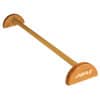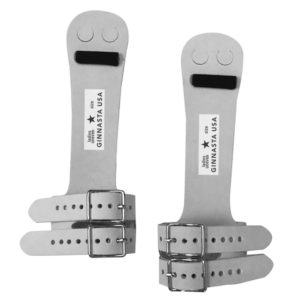So, you’ve got a gymnast who swings from every railing that she sees? Are you looking for a safer way for her to practice her gymnastics skills? No worries, here you’ll find a guide to buying gymnastics bars for home, along with links to several recommended bars.
This post may contain affiliate links. As an Amazon Associate I earn from qualifying purchases.
Types of Gymnastics Bars for Home
There are different types of gymnastics bars for home use. You’ll want to choose one that meets your gymnast’s needs, and that can grow with her as she grows and improves.
The first bar that many people choose is a low bar, or beginner bar. Beginner bars are great for learning skills such as pullovers, hip circles, and kips. Young gymnasts can hang or swing from this type of bar, but as they get taller, they’ll need a higher bar if they want to swing. Many of these beginner bars are less expensive, but it’s never a bad idea to pay a bit more for more stability.
If your gymnast has learned more advanced skills and wants to practice swings or giants, she’ll need a high bar. High bars are typically outdoor bars, due to the height needed for the gymnast to practice with them. These bars need to be installed with concrete, and as a result they are very stable. Buying one is a commitment, so these are best for serious gymnasts.
Another option is a floor bar. These bars are commonly used during practice for positioning and drills. They are helpful for casting, squat on jump to high bar, handstand positioning, and pirouettes, just to name a few. Ask your coach for ideas for drills on your floor bar, that will help with the skills you’re currently working on!
Regardless of the type of bar you choose, you’ll want a mat to go under it. Some bars come with a mat as part of a package, but if yours doesn’t, check out Gymnastics Mats for Home to keep your gymnast safe!
How to Choose a Gymnastics Bar
It’s always best to start by checking your gymnast’s size and weight, and the space you have available in your home. Each bar has a weight limit. Make sure you’re looking at the “working load” that the bar can support, not just the static weight limit. This will give you a true measure of the weight the bar can support while the gymnast is performing skills on it.
Next, evaluate the size and current level of your gymnast. Small gymnasts, especially those who are just beginning, can really use any beginner bar. If you aren’t sure how much use she’ll get out of it, you may want to start with a less expensive one.
Obviously, you’ll want a bar that fits in your space. If you have a smaller space, you’ll need a bar with a smaller base. However, that can compromise the stability of the bar. Especially as your gymnast grows, she will need a more stable bar to safely perform her skills.
If your gymnast is working on low bar skills, and you have a feeling she’ll stick with it for a while, you might want to invest in a better low bar with more stability. Look for one with a large base, or one that includes extenders for extra stability.
If your gymnast mainly wants to practice her high bar skills at home, you’ll want to look into getting an outdoor high bar. This type of bar will need a relatively permanent installation, so make sure you have the space to put it, as well as extra matting. A gymnast jumping down from a high bar exerts more force than one getting off a low bar, and proper matting is a must for safety.
Speaking of safety, it goes without saying that any gymnastics bar for home comes with a certain amount of inherent risk. If your gymnast wants to improve her bar skills, but you’re concerned about injuries, a floor bar can be a great option. It allows her to work on her positioning, while staying close to the ground the entire time. However, if she really wants to practice her skills, it won’t quite give her the same satisfaction. Make sure you discuss it with her so that you’re all on the same page.
Beginner Bars for Home
There are many options for low bars, or beginner bars for home. It’s easy to get overwhelmed! Let’s take the guesswork out of it. Here are the top picks for a beginner bar.

Here is an example of a beginner bar. This bar is called the Tumbl Trak Junior Kip Bar. It has a weight limit (working load) of 125 lbs. The bar adjusts from 38″-56″ high, so your gymnast can continue to use it as she grows. This bar also has a version with extensions, which allow bigger and heavier gymnasts to use the bar. If you purchase the regular bar, you can buy extensions separately when you need them.
Tumbl Trak is a long-standing, reputable gymnastics equipment company. They have been around for over 30 years. If you’re concerned about buying a piece of equipment online, you won’t need to worry about the quality of the equipment or service by going with Tumbl Trak.

This is the Z Athletic Expandable Kip Bar with foldable panel mat. This bar comes with a mat underneath it, which is a nice option and could save you a little money. The bar adjusts from 36″-58″, and has a weight limit of 120 lbs. It is marketed to work great for gymnasts up to Level 3 or 4. It comes in multiple colors.

The Shiwei gymnastics training bar gets great reviews! It adjusts from 3′-5′ high, so it can grow with your gymnast. This bar is very sturdy and boasts a weight limit of 330 lbs (I’d be shocked if that was the working load, though). It comes in pink. A mat is not included, but can be purchased to go along with the bar.

If you’re looking for a higher-end low bar, check out the Tumbl Trak Junior Bar Pro. This bar provides more stability as the gymnast starts to perform harder skills. The reason it is more stable is that it has a 4’x6′ floor stamp, meaning the floor area it covers. Keep that in mind when you’re buying matting to go underneath! The bar has a weight limit of 125 lbs (working load).
High Bars for Home
If your gymnast is starting to outgrow her low bar, or wants to swing some bigger skills at home, then a high bar for home might be the right fit for her. There aren’t nearly as many options for high bars, and there’s really only one that I can personally attest to.

This Z ATHLETIC Outdoor Training Bar for Gymnastics and Exercise“>high bar by Z Athletic is designed for outdoor use. It is 70 inches tall, but can be made lower by burying it further into the ground. It needs to be held in place by 200-220 pounds of concrete. Also, be sure to have adequate matting underneath for falls and dismounts.
The bar has a weight limit of 250 lbs, so parents can try it out too! It’s the perfect bar for more advanced gymnasts who want to work on their high bar skills.
Floor Bars for Home

This floor bar by Tumbl Trak has velcro on its base, to help secure it to carpet for a non-slip surface. It is 48″ long, and 1.5″ in diameter. This bar also has padded covers for the ends, to avoid injury and damage to your home.

Here’s another option for a floor bar, with this AAI Single Floor Training Rail. AAI is a company that provides equipment to many gyms and competitions, so the quality will be consistent with what your gymnast is used to. It’s also 1.5″ in diameter, and the bar is 47″ long. It has a solid wood construction throughout, including the end braces.
Accessories for Home Gymnastics Bars
Mats

If you have a gymnastics bar at home, you’ll definitely need a mat underneath it to protect your gymnast from falls and poor landings. This Tumbl Trak panel mat comes in a variety of sizes. Most bars have a 4′ wide area underneath, but you can customize the length of the mat to your desired length. I would recommend at least 6′ long, but you may want a longer mat if your gymnast is taller, and if you have the space for it in your house.

If you want a thicker mat, try a practice mat like this one. It’s 4’x8′, so it will fit under a standard bar. The difference is that it is 4″ thick, and it is softer compared to the panel mat, which is only 2″ thick and not as soft. This practice mat also has handles for easy transport, if your gymnast wants to pull it out and practice tumbling!
Bar Pads

Bar pads provide a cushion if the gymnast’s hips are bruised or bleeding. This junior bar pad fits any bar, and can help your gymnast to be more comfortable while using her bar at home. It’s not a necessity for every gymnast, but it can be useful if your gymnast has sore hips.
Grips
As your gymnast progresses, her coach will eventually recommend that she wear a pair of grips. There are different types of grips to fit different needs. A full description of the different types of grips can be found in The Ultimate Guide to Gymnastics Grips. Here are a couple of different types:

Beginner grips fit over the palm, and do not cover the fingers. These grips usually attach with velcro. This picture shows the Gibson rainbow palm grips. These grips come in several colors and sizes, to suit your gymnast’s hands and preferences. The finger holes will be small when the grips arrive, but they can be sanded to make them larger.

Dowel grips are for gymnasts who are working on the high bar. Your coach will tell you when your gymnast needs dowel grips. Dowel grips cover the fingers as well as the palm, and they have a dowel rod under the fingertips to help the gymnast hold onto the bar. Here’s a great pair of Ginnasta dowel grips. These grips are well-loved because they have minimal to no break-in time. They come in narrow width and regular width, and they have options for velcro, single buckle, and double buckle.
Wristbands

Wristbands are necessary to wear under gymnastics grips, to prevent rips and blisters on the wrists. These wristbands are 4″ long and come in multiple colors to suit your preferences. Some gymnasts prefer a set of longer wristbands (5″). These also come in multiple colors, and the extra length can be helpful especially for gymnasts who are using double buckle grips.
Tape

Some gymnasts like to use athletic tape, either under their grips, or under their wristbands. Athletic tape comes by the roll or also in bulk.
Pre-wrap

Some gymnasts like to wear pre-wrap around their wrists. It can either be worn alone, or in combination with wristbands for a thicker cushion. Pre-wrap is nice to have on hand as an extra layer. It’s also available in rainbow colors, if your gymnast wants to match her grips or wear different colors on different days!
Further Reading
Ultimate Guide to Gymnastics Grips
The Best Gymnastics Mats for Home
